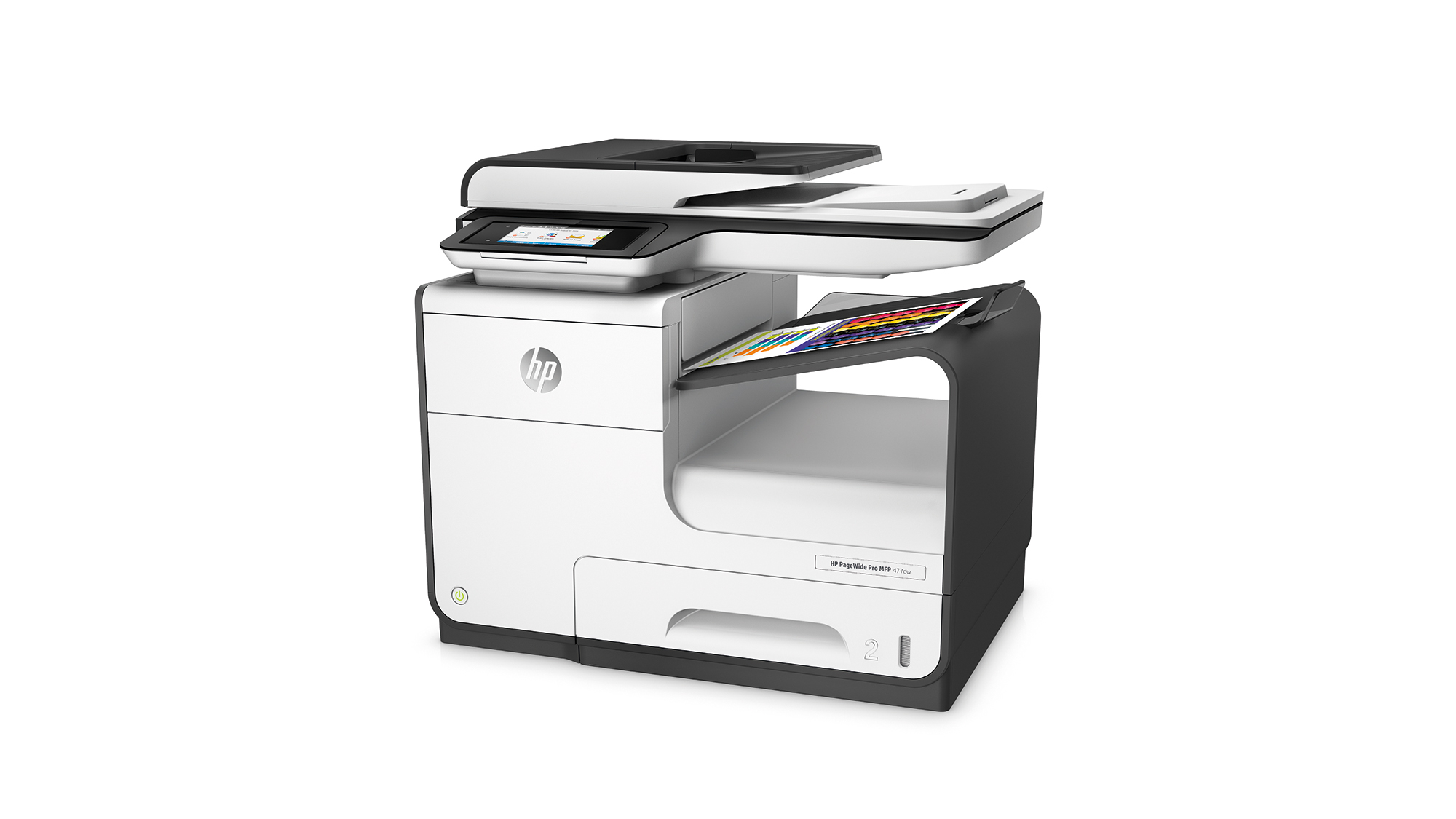HP PageWide Pro 477dw review: A genuine laser-killer
Want an MFP for office work? The 477dw is nothing short of brilliant


It’s hard to argue against the HP PageWide 477dw for a busy small office. Yes it’s sensitive to paper quality, but any extra cost there is more than offset by savings on ink. Otherwise it’s fast, comparatively stylish, and produces great results. We can’t see a compelling reason not to choose it over a laser.
-
+
Incredible speeds; Great quality; Superb value
-
-
Image quality is somewhat dependant on paper quality

HP's PageWide Pro 477dw is one of the most expensive inkjets in its category, but it's quite unlike any other you've used. The clue's in the name: while the print heads in a normal inkjet whizz back and forth across the paper, which has to wait for them to cross, in HP's PageWide system there's a single set of heads spanning the full width of the page. Freed from the need to wait for moving print heads, the paper can get a shift on. For the 477dw, HP quotes a maximum speed of 55 pages per minute - the realm of high-end workgroup laser printers - although at the default quality it's a more modest 40ppm.
The PageWide Pro 477dw isn't really out to get small office inkjets; it's positioned as a genuine rival to laser devices. Considering this, HP has wisely avoided small ink cartridges in favour of genuinely heavy duty supplies: the 477dw arrives with about 3,000 pages worth of black ink and 1,500 of colour, and replacement supplies are rated at 10,000 black pages and 7,000 for each of cyan, magenta and yellow. That cuts down on maintenance and waste, but it also means low running costs: each page of text and graphics will cost about 4.7p, of which the black component is less than a penny.
Several years after the debut of PageWide technology, there's still a sense of surprise that an inkjet can print this quickly. Send a print job, wait for the dust cover to motor open, then watch as pages cascade into the swoopy output tray. This was comfortably one of the quickest colour printers we've tested, dispatching 25 pages of black text at 34.9ppm, and extending this to 44.8ppm over a 100-page job when we dropped the quality to the lowest "General Office" setting. It delivered our complex colour graphics test at an impressive 21.2ppm, and reached 12.2 images per minute (ipm) on our graphics duplex test. Kyocera's Ecosys M2640idw was about 25% faster on the latter two, but it's a mono laser costing significantly more.
We're not that keen on HP's overly prescriptive TWAIN scan interface, but it's hard to fault the 477dw's scan performance. Tested over wired Ethernet it could deliver A4 scans at either 150dpi or 300dpi in just eight seconds. A 600dpi 6 x 4in photo scan was just as fast, and at 1,200dpi the capture completed in 27 seconds. Perhaps not surprisingly, photocopies were also brisk, with a single page needing just 11 seconds. A 10-page ADF copy took 34 seconds in black, or 44 seconds in colour. With the ADF handling duplex scans in a single pass, double-sided copying is also very quick.
As with any inkjet, there's a trade-off between speed and quality, but even at the fastest setting prints were far better than a typical inkjet's draft mode. The default "Professional" setting produced strong black text and punchy colour graphics free from banding, grain or other inkjet artefacts. Photos were about as good as we'd expect from a colour laser, although the colour balance of both photo and graphical prints proved sensitive to paper quality, with the best results coming on thicker, whiter stock. Both also missed the waxy sheen typical of a good colour laser print.
With the same caveats, photocopies were excellent, with unusually good colour and shade reproduction. Scans were also more than good enough for office purposes, although high-resolution photo scans appeared to have been sharpened, making them seem artificial at 100% zoom.
HP LaserJet Pro M15w review: The smallest laser ever? Best printers 2021: For all your printing, scanning and copying needs Brother MFC-L2710DW review: Looks that only Brother could love
Broadly, the 477dw matches the quality of a colour laser, but it's much faster and quieter than any laser in the same price range, and costs less than half as much to run. It has some other key advantages: with no fuser to heat, its power consumption is far lower - we measured a peak of 58 Watts, compared to 1,079W for the Xerox WorkCentre 6515. Finally, it's quicker to get going: from standby the 477dw spat out a first page in just seven seconds, although after an hour sitting idle this did rise to a more laser-like 17 seconds.
In truth, it's hard to argue against the PageWide 477dw for a busy small office. Yes it's sensitive to paper quality, but any extra cost there is more than offset by savings on ink. Otherwise it's fast, comparatively stylish, and produces great results. We can't see a compelling reason not to choose it over a laser.
Get the ITPro daily newsletter
Sign up today and you will receive a free copy of our Future Focus 2025 report - the leading guidance on AI, cybersecurity and other IT challenges as per 700+ senior executives
After a brief career in corporate IT, Simon Handby combined his love of technology and writing when he made the move to Computer Shopper magazine. As a technology reviewer he's since tested everything from routers and switches, to smart air fryers and doorbells, and covered technology such as EVs, TVs, solar power and the singularity.
During more than 15 years as Shopper's long-time printer reviewer, Simon tried, tested and wrote up literally hundreds of home, small office and workgroup printers. He continues reviewing smart products and printers for a variety of publications, and has been an IT Pro contributor since 2010. Simon is almost never happier than when surrounded by printers and paper, applying his stopwatch and a seasoned eye to find the best performing, best value products for business users.
-
 ‘Phishing kits are a force multiplier': Cheap cyber crime kits can be bought on the dark web for less than $25 – and experts warn it’s lowering the barrier of entry for amateur hackers
‘Phishing kits are a force multiplier': Cheap cyber crime kits can be bought on the dark web for less than $25 – and experts warn it’s lowering the barrier of entry for amateur hackersNews Research from NordVPN shows phishing kits are now widely available on the dark web and via messaging apps like Telegram, and are often selling for less than $25.
By Emma Woollacott Published
-
 Redis unveils new tools for developers working on AI applications
Redis unveils new tools for developers working on AI applicationsNews Redis has announced new tools aimed at making it easier for AI developers to build applications and optimize large language model (LLM) outputs.
By Ross Kelly Published
-
 Google layoffs continue with "hundreds" cut from Chrome, Android, and Pixel teams
Google layoffs continue with "hundreds" cut from Chrome, Android, and Pixel teamsNews The tech giant's efficiency drive enters a third year with devices teams the latest target
By Bobby Hellard Published